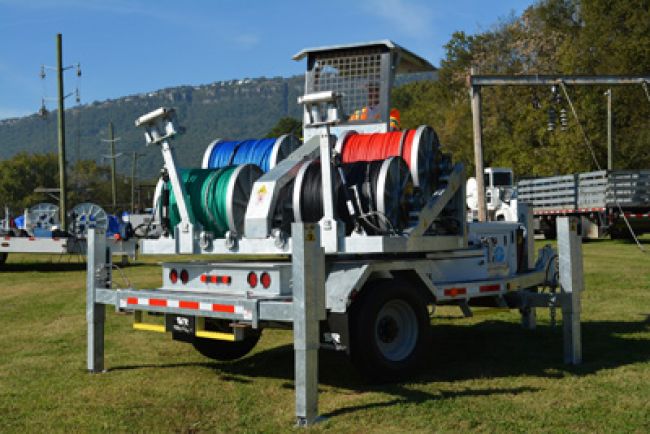
Spec’ing the Right Cable Reel Trailer
Capacity, safety and flexibility top the list of features that manufacturers say should be on a utility’s spec sheet for any new cable reel trailer. But a good spec doesn’t end there. How many reels will be hauled or needed each time? Where will the trailer be used? Will loading be manual or automated? What type of operation is being performed? Is it an underground conductor? Overhead? The list of spec’ing considerations can be a yard long.
“[Spec’ing] reel trailers is one of the hardest things to do just because there are so many variables,” said Mark Rapp, product manager for utility and telecom products with Felling Trailers Inc. (www.felling.com). “Reel trailers are very customizable.”
But if there is one piece of advice manufacturers said they give utilities, it is to spec for capacity.
“By far the biggest mistake when specifying a trailer is [under-spec’ing] reel weight,” Rapp said. A reel-carrying assembly rated to haul a 60-inch-wide reel that weighs 6,000 pounds may not be rated to haul a 48-inch-wide reel that weighs the same because the narrower reel puts more weight on the center of the reel bar whereas the wider reel’s weight is closer to the carrier.
“So, it’s important to know the range of reels sizes that are going to be hauled,” Rapp said.
Safety is always an important consideration when spec’ing cable reel trailers, said Glen Schulz, sales manager for American Eagle Accessories Group (http://americaneagleacc.com). “Whether the end user is a utility company or a utility construction contractor, [crews] are out in the field potentially using these trailers every day, so the trailers need to be safe and built to withstand the rigors of the daily grind.”
Beyond the basic specs for capacity and durability lies a wide range of options, depending on the need, Schulz said. Does the utility need a self-loading unit or drop-on unit that loads with a loader or forklift? Does it want manual or electric hydraulics for the reel lift? Does the trailer need a rewind capability? Will the rewind be powered by tow vehicle hydraulics or a self-contained unit powered by a gas engine?
“Whether a customer just needs a basic reel carrier or a trailer that is expected to do more, they just [have] to determine their need,” Schulz said.
According to Mike Turpin, product manager with Sherman + Reilly (https://www.sherman-reilly.com/), utilities should spec for the capacity and footprint that fit the conductor size, worksite conditions and spacing, such as transmission, distribution, substation or underground.
Additionally, utilities should consider features that enhance ease of use and reliability. These might include a rotating turret, hydraulic retrieval, sealed bearings and proper trailer jacks, among others, Turpin said.
“Ease of use and reliability are the basis for operator safety,” he noted. “Talk to your linemen to get good feedback on what features get the job done efficiently and keep them safe.”
About the Author: Jim Galligan has been covering the commercial truck transportation sector for more than 30 years and has extensive experience covering the utility fleet market. In addition to writing and editing for magazines, his background also includes writing for daily newspapers, trade associations and corporations.
*****
What’s Your Budget?
Cable reel trailer costs will vary greatly depending on weight-carrying requirements and options, said Mark Rapp, product manager for utility and telecom products with Felling Trailers Inc. A simple single-reel trailer that can haul a 3,000-pound reel can start as low as $3,000. A three-reel trailer set up to haul 10,000-pound reels and loaded with options such as hydraulic payout/take-up assemblies and tensioning brakes can top $65,000.
*****
Don’t Forget Puller and Tensioner Specs
Today’s pullers and tensioners offer more specs while being safer and smarter than the industry’s earlier generations, said Mike Turpin, product manager with Sherman + Reilly.
“When sourcing equipment for your stringing operations, it’s important to look beyond the general capacity specs,” Turpin said. “This is especially true when sourcing multi-use equipment like pullers and tensioners. Besides asking ‘Can it do the job?’ you should also ask, ‘Can it help make the job site safer and more efficient?’ ‘Is it built to last?’”
Additionally, technology such as real-time display readouts for line tension, line speed, payout distance and engine performance will take the guesswork out of operations by providing easy-to-read information and should be at the top of the list when comparing pullers and tensioners, Turpin said.
“When selecting pullers and tensioners, confirm that they are not only up to completing the job but also support a safe and efficient worksite for linemen,” he advised.

